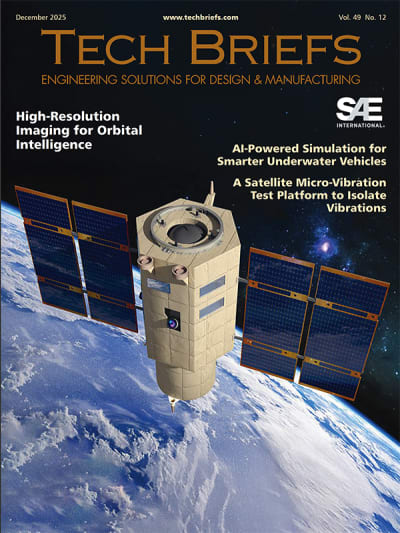
Innovators at NASA Johnson Space Center have developed a robotic system whose primary structural platform, or “orb,” can be injected into a pipe network and perform reconnaissance of piping infrastructure and other interior volumes. When deployed, this technology uses throttled fluid flow from a companion device for passive propulsion. A tethered line facilitates directional control by the orb’s operator, allowing it to navigate through various piping configurations, including 90° junctions.
The robotic system is comprises six main components: the orb that performs the reconnaissance, an orb injector housing that attaches to a piping network, a tether and reel subsystem that attaches to the back of the injector housing, a fluid injection subsystem that attaches toward the front of the injector housing, an external power and data subsystem, and associated control and monitoring software.
Usage of the system begins with an operator attaching the injector housing, with the orb stowed inside, to a flanged gate valve belonging to the piping network of concern. Requisite power, data, and fluid subsystems are attached, and the system is energized for usage. The orb is released via the tether and reel, and a controlled fluid force is imparted on the orb to help guide it along its mission. The tether supplies power and guidance to the orb, and relays real-time data back to the operator.
The orb’s interior features a modular plug-and-play architecture which may comprise COTS instrumentation for reconnaissance or investigation, LiDAR, and inertial measuring and motion sensors. This instrumentation could be used in combination with other sub-systems such as lighting, and core and sample retrieving mechanisms. These components are supported by other onboard devices such as a CPU, power source and controller, and data transmission encoders and multiplexers.
Inspired by NASA’s Robonaut program for space applications, this technology was developed to facilitate a cost-effective method to inspect deep underwater oil wells residing under oceanic drilling platforms slated for decommission. Instead of initiating an expensive and environmentally risky operation to perforate the containment system of an underwater oil well to inspect its contents, the orb can be navigated through existing pipe networks to conduct real-time video and sonar investigations.
The modular orb design accepts a variety of plug-and-play sensors along with a potential sample retrieving device, making it adaptable to different environments. Its housing can be easily disassembled in the field, enabling a change or maintenance of its sensors or electronics. Because piping exists in industries such as refineries, manufacturing and power plants, sewage systems, etc., plant operators could need a cost-effective reconnaissance device of this nature.
NASA is actively seeking licensees to commercialize this technology. Please contact NASA’s Licensing Concierge at

